
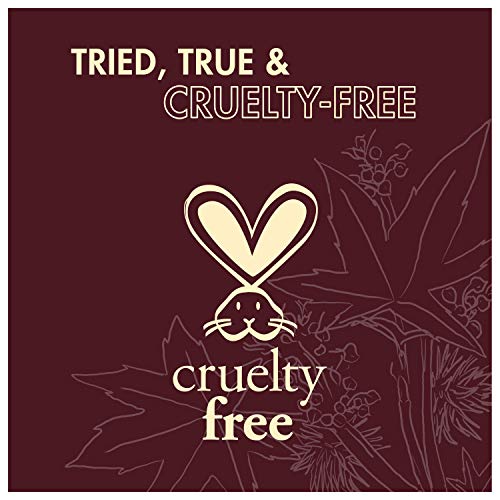
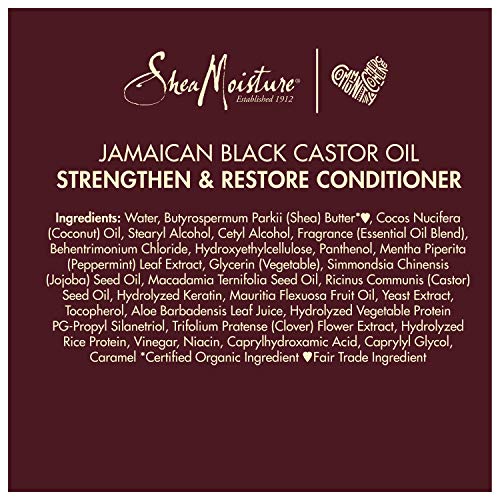
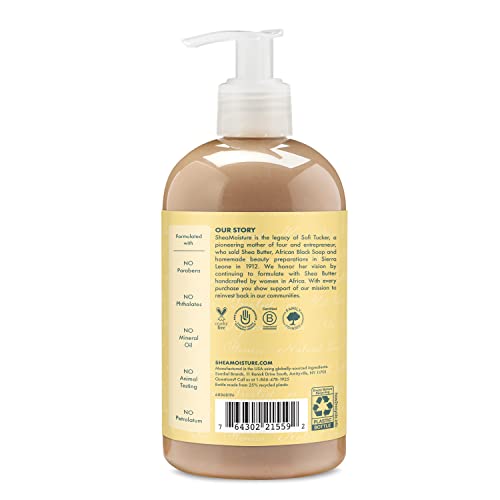
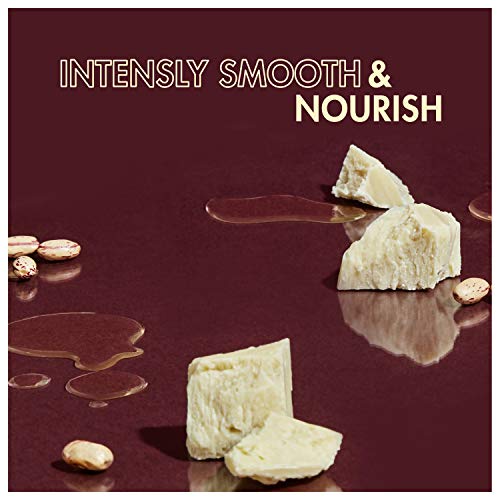
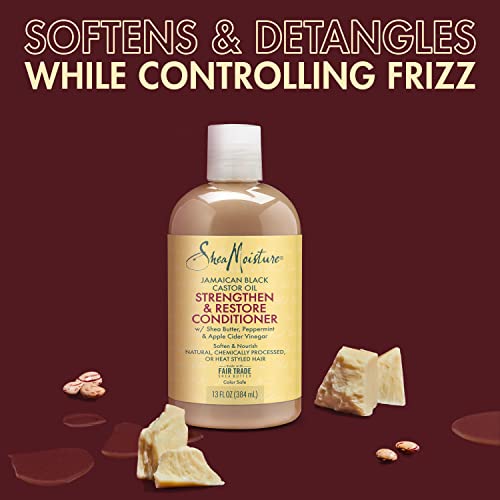

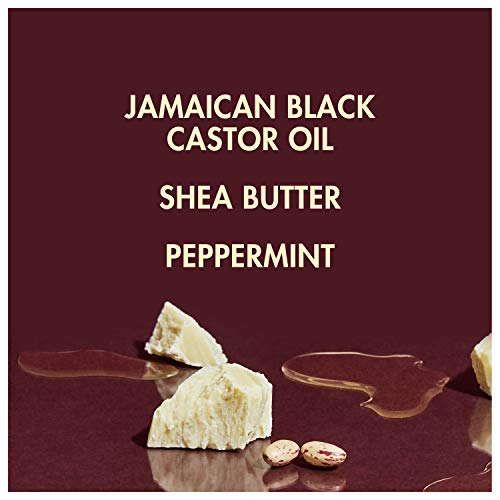
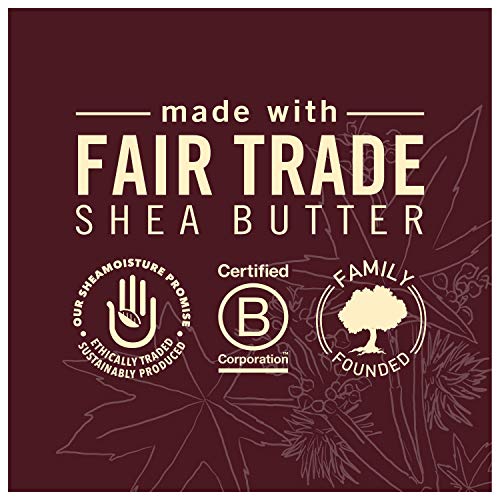
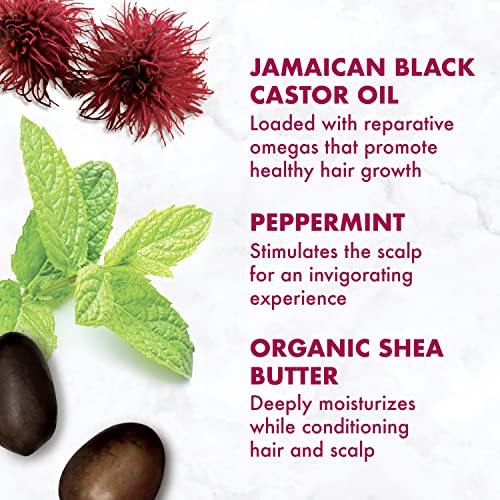
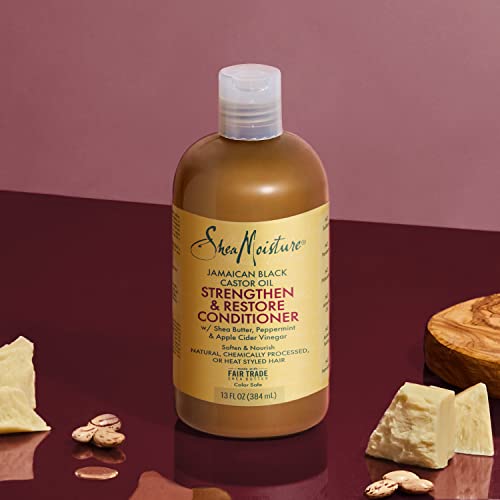

SheaMoisture Conditioner - Nourishes & Smooths Hair, Detangles & Controls Frizz - 13 oz


Behentrimonium Chloride
High RiskBehentrimonium chloride is a quaternary ammonium compound primarily used as a conditioning agent in hair and skin care products. It functions as an emulsifier and surfactant, helping to improve texture and manageability of hair.
Sustai Insights
Behentrimonium chloride offers functional benefits as a hair conditioner and emulsifier. However, it is associated with moderate allergenic potential and has high use restrictions due to regulatory concerns. It poses low risks for carcinogenicity and developmental toxicity but has been noted for neurotoxicity. Environmental risks include potential pollution and low biodegradability. Overall, the ingredient is assessed as high risk, and users should consider alternatives such as natural conditioners.
Fragrance
High RiskFragrance refers to a mixture of aromatic compounds used in products to provide scent. It is commonly listed as 'fragrance' or 'parfum' on product labels and can serve various functions, including enhancing user experience and masking undesirable odors.
Sustai Insights
Fragrance offers functional benefits by improving product appeal; however, it poses significant health risks, notably a high likelihood of causing allergies and allergic contact dermatitis. Environmental risks include potential pollution and endocrine disruption, though its overall carcinogenicity is low. Regulatory bodies have noted concerns regarding its use, leading to a high-risk classification. Safe usage practices should be observed, and alternatives such as natural essential oils are recommended for those sensitive to synthetic fragrances.
Mentha Piperita (Peppermint) Extract
High RiskMentha piperita extract, commonly known as peppermint extract, is derived from the leaves of the peppermint plant. It is used in various cosmetic and personal care products for its aromatic properties and potential soothing effects on the skin.
Sustai Insights
Mentha piperita extract offers functional benefits such as providing a cooling sensation and pleasant fragrance, enhancing product appeal. However, it carries a high risk of causing allergic reactions and skin irritation, particularly with sensitive individuals. Regulatory bodies have not imposed significant restrictions, but caution is advised due to its allergenic potential. Overall, the ingredient poses a high risk, especially for those with sensitivities, and should be used carefully, with alternatives available for those seeking less irritating options.
Ricinus Communis (Castor) Seed Oil
Medium RiskCastor oil is extracted from the seeds of Ricinus communis and is commonly used in cosmetic and personal care products for its moisturizing and emollient properties. It is known for its ability to enhance skin absorption and provide a protective barrier.
Sustai Insights
Castor oil offers functional benefits as a moisturizer and emollient, enhancing skin absorption and providing a barrier against moisture loss. It is sustainably sourced and biodegradable. However, potential health risks include low levels of irritation and moderate concerns regarding developmental and reproductive toxicity. Environmental risks are low, with no significant pollutant or bioaccumulation concerns reported. Regulatory status shows no current restrictions. Overall, the risk level is assessed as medium, with recommendations for safe usage practices, and potential alternatives include other plant-based oils.
Butyrospermum Parkii (Shea) Butter
Low RiskButyrospermum parkii (shea) butter is a vegetable fat derived from the nuts of the shea tree. It is commonly used in cosmetic formulations for its emollient properties, providing moisture and improving skin texture. Additionally, shea butter is known for its ability to enhance the stability of products and deliver a creamy texture.
Sustai Insights
Shea butter offers functional benefits as an effective moisturizer, enhancing skin barrier function and texture. It is sustainably sourced and biodegradable, contributing to eco-friendliness. Health-wise, it is associated with low risks for carcinogenicity, allergies, and reproductive toxicity. Environmental impacts are minimal, with no significant pollutant potential identified. Regulatory assessments indicate no current restrictions. Overall, the ingredient presents a low risk, making it a favorable choice in cosmetic formulations.
Mauritia Flexuosa Fruit Oil
Low RiskMauritia flexuosa fruit oil is a volatile oil extracted from the fruit of the Mauritia flexuosa palm, commonly known as buriti. It is often used in cosmetic formulations for its moisturizing properties and potential benefits for skin health. The oil is rich in carotenoids and fatty acids.
Sustai Insights
Mauritia flexuosa fruit oil offers functional benefits as a moisturizer and antioxidant due to its composition, which includes carotenoids. It is sustainably sourced and biodegradable. Health risks associated with this ingredient are low, with no known carcinogenic, allergenic, or reproductive toxicity concerns. Environmental risks are minimal, as it does not contribute to pollution or bioaccumulation. Regulatory status shows no significant restrictions. Overall, the risk level is low. Safe usage practices are encouraged, and alternatives include other natural oils like argan or jojoba oil for similar benefits.
Trifolium Pratense (Red Clover) Extract
Low RiskTrifolium pratense (red clover) extract is derived from the flowers of the red clover plant. It is commonly used in various products for its phytoestrogen content, which mimics estrogen in the body, and is often included in formulations aiming to address hormonal balance.
Sustai Insights
This ingredient offers functional benefits as a natural source of phytoestrogens, which may aid in hormonal regulation. It is generally considered low risk for health concerns, such as cancer, allergies, and reproductive toxicity. Environmental risks are minimal, with no significant pollutant potential. Regulatory bodies do not impose restrictions on its use. Overall, red clover extract is assessed as low risk, suitable for inclusion in products with consideration for sensitive populations, and potentially replaced by other phytoestrogen sources.
Water
Low RiskWater is a clear, colorless liquid essential for various biological processes. It serves as a solvent in formulations, facilitating the dissolution of other ingredients and enhancing product texture and application. Additionally, water plays a crucial role in hydration and is a key component in many cosmetic and personal care products.
Sustai Insights
Water is an effective solvent and hydrator, contributing to the texture and efficacy of formulations. It is biodegradable and generally regarded as safe, with low concerns regarding carcinogenicity, allergies, and reproductive toxicity. However, excessive water usage can lead to environmental concerns, particularly regarding resource depletion. Regulatory bodies do not impose restrictions on water use in cosmetics. Overall, the risks associated with water are low, making it a safe and essential ingredient.
Hydrolyzed Rice Protein
Low RiskHydrolyzed rice protein is a hydrolysate of rice protein, commonly used in cosmetic and personal care products for its film-forming and moisturizing properties. It serves as a conditioning agent that can enhance the texture and feel of formulations.
Sustai Insights
Hydrolyzed rice protein offers functional benefits such as improving moisture retention and hair manageability. It is derived from renewable sources and is biodegradable. Health risks are generally low, with minimal concerns regarding carcinogenicity, allergies, or reproductive toxicity. However, contamination concerns are noted. Environmental risks appear low, with no significant pollutant or bioaccumulative properties. Regulatory status indicates no major restrictions. Overall, the risk level is assessed as low, making it a viable ingredient in formulations with appropriate usage practices.
Cocos Nucifera (Coconut) Oil
Low RiskCocos Nucifera (Coconut) Oil is derived from the kernels of the coconut palm. It is primarily used in cosmetic formulations for its emollient and moisturizing properties, making it suitable for skin and hair care products.
Sustai Insights
Coconut oil serves as an effective moisturizer and emollient, promoting skin hydration and softness. It is sustainably sourced and biodegradable. Health risks are minimal, with low concerns regarding carcinogenicity, allergens, and reproductive toxicity. Environmental impact is also low, as it does not contribute significantly to pollution or bioaccumulation. Regulatory bodies have not issued restrictions on its use. Overall, coconut oil presents a low risk for health and environmental concerns, making it a safe ingredient in cosmetic products.
Vitamin B3
Low RiskVitamin B3, also known as niacin or nicotinic acid, is an organic compound that plays a crucial role in various metabolic processes in the body. It is commonly used in cosmetic formulations for its ability to improve skin texture and enhance moisture retention, thereby contributing to overall skin health.
Sustai Insights
Vitamin B3 offers functional benefits such as improving skin hydration, reducing the appearance of fine lines, and enhancing overall skin tone. It is generally recognized as safe, with low associated health risks, including minimal concerns for carcinogenicity, allergies, or reproductive toxicity. Environmentally, it poses low risks and is not classified as a pollutant or bioaccumulative. Regulatory bodies have not placed substantial restrictions on its use, affirming its safety in cosmetic applications. Overall, Vitamin B3 is considered a low-risk ingredient, with no significant adverse effects reported. Safe usage practices include using within recommended concentrations, and alternatives like Vitamin B5 can be considered for similar benefits.
Hydrolyzed Vegetable Protein Pg Propyl Silanetriol
Low RiskHydrolyzed vegetable protein PG-propyl silanetriol is a modified protein derived from vegetable sources, used in cosmetic formulations primarily for its conditioning properties. It acts as a moisturizing agent and film-forming agent, enhancing the texture and feel of products.
Sustai Insights
Hydrolyzed vegetable protein PG-propyl silanetriol offers functional benefits as a moisturizing and conditioning agent in personal care products. It is considered low risk for health concerns, with minimal evidence of carcinogenicity, allergies, or reproductive toxicity. Environmentally, it poses low pollutant and bioaccumulation risks, with no current regulatory restrictions. Safe usage practices involve adhering to product guidelines, and while alternatives exist, they may not replicate all functional benefits. Overall, this ingredient is assessed as low risk based on current scientific consensus.
Tocopherol, D Alpha
Low RiskTocopherol, specifically d-alpha tocopherol, is a naturally occurring form of Vitamin E. It is commonly used in cosmetic and personal care products primarily for its antioxidant properties, helping to protect formulations from oxidation and extend shelf life.
Sustai Insights
D-alpha tocopherol provides effective antioxidant benefits, contributing to product stability. It is sustainably sourced and generally regarded as safe, with low concerns regarding carcinogenicity, allergies, and reproductive toxicity. However, there are minor concerns about endocrine disruption. Regulatory bodies have not imposed significant restrictions, indicating low overall risk. Recommended usage practices include adhering to established safe concentration thresholds. Alternatives, such as other forms of Vitamin E or plant-based antioxidants, may also be considered.
Caprylyl Glycol
Low RiskCaprylyl glycol (1,2-octanediol) is a multifunctional cosmetic ingredient primarily used as a skin-conditioning agent and preservative. It is derived from caprylic acid, a fatty acid found in coconut oil, and is commonly included in personal care products for its moisturizing properties.
Sustai Insights
Caprylyl glycol offers functional benefits such as acting as an effective humectant and preservative, enhancing skin hydration and product stability. It is considered to have low health risks, with no significant concerns regarding carcinogenicity, allergies, or reproductive toxicity. Environmentally, it poses minimal risks, being non-bioaccumulative and not linked to pollution. Regulatory assessments affirm its safety, with no major advisories against its use. Overall, the ingredient is assessed to have a low risk, making it a suitable choice in cosmetic formulations.
Yeast Extract
Low RiskYeast extract is an extract derived from yeast, commonly used in food and cosmetic products for its flavor-enhancing and nutritional properties. It contains amino acids, vitamins, and minerals that contribute to its functional benefits.
Sustai Insights
Yeast extract serves as a flavor enhancer and nutrient source, contributing to product efficacy. It is generally recognized as safe with low concerns for carcinogenicity, allergies, or reproductive toxicity. Environmental impact is minimal, with no significant pollutant or bioaccumulation potential. Regulatory bodies, such as the FDA, impose no restrictions. Overall, it presents a low-risk profile, with no notable health or environmental hazards, making it a viable ingredient in various applications.
Stearyl Alcohol
Low RiskStearyl alcohol is a compound produced from the hydrogenation of stearic acid, commonly used in cosmetic formulations as an emulsifier and thickening agent. It helps stabilize products by blending oil and water phases, enhancing texture and consistency.
Sustai Insights
Stearyl alcohol provides functional benefits as an emulsifier and stabilizer, contributing to improved product texture. It is generally regarded as safe with low concerns for cancer, allergies, and reproductive toxicity. However, it may cause moderate skin, eye, or respiratory irritation. Regulatory bodies do not impose significant restrictions, indicating a low overall risk. While it poses minimal health and environmental hazards, caution is advised for sensitive individuals. Alternatives like cetyl alcohol or plant-based emulsifiers may offer safer options for formulators.
Vegetarian Glycerin
Low RiskVegetarian glycerin, also known as glycerol, is a colorless, odorless, and viscous liquid derived from plant sources. It is primarily used as a humectant, solvent, and emollient in various personal care products, helping to retain moisture and improve texture.
Sustai Insights
Vegetarian glycerin offers functional benefits as an effective humectant, promoting hydration and skin smoothness. It is biodegradable and typically sustainably sourced. Health risks associated with glycerin are low, with no significant concerns for carcinogenicity, allergens, or reproductive toxicity. Environmental risks are minimal, and it is not subject to major regulatory warnings. Overall, the risk level for this ingredient is low, making it a safe choice in formulations. Safe usage practices include ensuring proper concentrations in products, and alternatives such as propylene glycol exist but may have differing properties.
Hydrolyzed Keratin
Low RiskHydrolyzed keratin is a hydrolysate of keratin, a fibrous protein found in hair, skin, and nails. It is commonly used in cosmetic and personal care products to improve texture and strength, providing conditioning and moisturizing benefits to hair and skin.
Sustai Insights
Hydrolyzed keratin offers functional benefits as a conditioning agent, enhancing the texture and strength of hair and skin, and is often sourced sustainably. Health risks are low, with no significant concerns regarding carcinogenicity or irritancy. Environmental impacts are minimal, and regulatory bodies impose few restrictions. Overall, the risk level is assessed as low, and safe usage practices are recommended. Alternatives like plant-based proteins may offer similar benefits in a more sustainable manner.
Apple Cider Vinegar
Low RiskApple cider vinegar is a fermented liquid made from crushed apples and is commonly used in food for flavoring, as a preservative, and in cleaning products due to its antibacterial properties. It is widely recognized for its culinary applications and potential health benefits.
Sustai Insights
Apple cider vinegar serves effectively as a preservative and flavoring agent, with some sustainability benefits due to its biodegradable nature. Health risks are minimal, with low concerns for carcinogenicity, allergies, and reproductive toxicity. It poses low environmental risks and is not currently restricted by regulatory bodies. Overall, it is considered a low-risk ingredient. For those seeking alternatives, other vinegar types or natural preservatives may be appropriate.
Panthenol, D
Low RiskPanthenol, also known as provitamin B5, is a humectant commonly used in cosmetic and personal care products. It functions primarily as a moisturizer, enhancing skin hydration and improving the appearance of hair by imparting shine and softness.
Sustai Insights
Panthenol is effective in retaining moisture, thus providing functional benefits for skin and hair care products. It is generally recognized as safe, with low concerns regarding carcinogenicity, allergies, and developmental toxicity. However, potential cumulative exposure from multiple sources exists. Environmental risks are minimal, and it is not bioaccumulative. Regulatory bodies have not issued significant warnings; therefore, the overall risk level is assessed as low. For optimal use, it is recommended to follow product guidelines, and alternatives such as glycerin may also be considered for moisturizing effects.
Hydroxyethylcellulose
Low RiskHydroxyethylcellulose is a modified cellulose polymer used primarily as a thickening agent and stabilizer in various cosmetic and personal care products. It is soluble in water and helps to improve the texture and viscosity of formulations, enhancing their usability and performance.
Sustai Insights
Hydroxyethylcellulose offers functional benefits such as effective thickening and stabilization in formulations, contributing to product texture. It is generally considered low-risk in terms of health, with minimal concerns regarding carcinogenicity, allergens, or reproductive toxicity. Environmentally, it poses low risks and is not known to be bioaccumulative. Regulatory bodies have not imposed significant restrictions on its use. Safe practices include adhering to recommended concentrations, and while alternatives exist, hydroxyethylcellulose remains a low-risk ingredient overall.
Cetyl Alcohol
Low RiskCetyl alcohol is a long-chain organic alcohol commonly used in cosmetic formulations. It serves as an emollient, emulsifier, and thickening agent, enhancing the texture and stability of products. Cetyl alcohol is derived from natural sources, such as coconut or palm oil, and is often included in creams, lotions, and hair conditioners.
Sustai Insights
Cetyl alcohol offers functional benefits as an emollient and emulsifier, improving product texture and stability. It is biodegradable and sourced from renewable materials, contributing to sustainability. Health risks are minimal, with low concerns for carcinogenicity, allergies, or reproductive toxicity. Environmental impact is also low, with no significant pollutant or bioaccumulation potential. Regulatory bodies have not placed restrictions on its use, indicating a favorable safety profile. Overall, cetyl alcohol is assessed as low risk, and safe usage practices include ensuring proper formulation concentrations.
Simmondsia Chinensis (Jojoba)
Low RiskSimmondsia chinensis, commonly known as jojoba, is an oil derived from the seeds of the jojoba plant. It is commonly used in cosmetic formulations for its moisturizing properties, acting as an emollient and skin conditioning agent.
Sustai Insights
Jojoba oil offers functional benefits such as effective skin moisturization and is biodegradable, with sustainable sourcing practices. Health risks are low, with minimal concerns regarding carcinogenicity, allergies, and reproductive toxicity. Environmental impact is negligible, with no pollutant or bioaccumulation potential. Regulatory status is favorable with no significant restrictions noted. Overall, it is assessed as low risk, and safe usage practices should be maintained. Alternatives include other plant-derived oils like argan or almond oil, which may provide similar benefits.
Butyrospermum Parkii (Shea) Butter
Low RiskButyrospermum parkii (shea) butter is a vegetable fat derived from the nuts of the shea tree. It is commonly used in cosmetic formulations for its emollient properties, providing moisture and improving skin texture. Additionally, shea butter is known for its ability to enhance the stability of products and deliver a creamy texture.
Sustai Insights
Shea butter offers functional benefits as an effective moisturizer, enhancing skin barrier function and texture. It is sustainably sourced and biodegradable, contributing to eco-friendliness. Health-wise, it is associated with low risks for carcinogenicity, allergies, and reproductive toxicity. Environmental impacts are minimal, with no significant pollutant potential identified. Regulatory assessments indicate no current restrictions. Overall, the ingredient presents a low risk, making it a favorable choice in cosmetic formulations.
Behentrimonium Chloride
High RiskBehentrimonium chloride is a quaternary ammonium compound primarily used as a conditioning agent in hair and skin care products. It functions as an emulsifier and surfactant, helping to improve texture and manageability of hair.
Sustai Insights
Behentrimonium chloride offers functional benefits as a hair conditioner and emulsifier. However, it is associated with moderate allergenic potential and has high use restrictions due to regulatory concerns. It poses low risks for carcinogenicity and developmental toxicity but has been noted for neurotoxicity. Environmental risks include potential pollution and low biodegradability. Overall, the ingredient is assessed as high risk, and users should consider alternatives such as natural conditioners.
Mauritia Flexuosa Fruit Oil
Low RiskMauritia flexuosa fruit oil is a volatile oil extracted from the fruit of the Mauritia flexuosa palm, commonly known as buriti. It is often used in cosmetic formulations for its moisturizing properties and potential benefits for skin health. The oil is rich in carotenoids and fatty acids.
Sustai Insights
Mauritia flexuosa fruit oil offers functional benefits as a moisturizer and antioxidant due to its composition, which includes carotenoids. It is sustainably sourced and biodegradable. Health risks associated with this ingredient are low, with no known carcinogenic, allergenic, or reproductive toxicity concerns. Environmental risks are minimal, as it does not contribute to pollution or bioaccumulation. Regulatory status shows no significant restrictions. Overall, the risk level is low. Safe usage practices are encouraged, and alternatives include other natural oils like argan or jojoba oil for similar benefits.
Trifolium Pratense (Red Clover) Extract
Low RiskTrifolium pratense (red clover) extract is derived from the flowers of the red clover plant. It is commonly used in various products for its phytoestrogen content, which mimics estrogen in the body, and is often included in formulations aiming to address hormonal balance.
Sustai Insights
This ingredient offers functional benefits as a natural source of phytoestrogens, which may aid in hormonal regulation. It is generally considered low risk for health concerns, such as cancer, allergies, and reproductive toxicity. Environmental risks are minimal, with no significant pollutant potential. Regulatory bodies do not impose restrictions on its use. Overall, red clover extract is assessed as low risk, suitable for inclusion in products with consideration for sensitive populations, and potentially replaced by other phytoestrogen sources.
Fragrance
High RiskFragrance refers to a mixture of aromatic compounds used in products to provide scent. It is commonly listed as 'fragrance' or 'parfum' on product labels and can serve various functions, including enhancing user experience and masking undesirable odors.
Sustai Insights
Fragrance offers functional benefits by improving product appeal; however, it poses significant health risks, notably a high likelihood of causing allergies and allergic contact dermatitis. Environmental risks include potential pollution and endocrine disruption, though its overall carcinogenicity is low. Regulatory bodies have noted concerns regarding its use, leading to a high-risk classification. Safe usage practices should be observed, and alternatives such as natural essential oils are recommended for those sensitive to synthetic fragrances.
Water
Low RiskWater is a clear, colorless liquid essential for various biological processes. It serves as a solvent in formulations, facilitating the dissolution of other ingredients and enhancing product texture and application. Additionally, water plays a crucial role in hydration and is a key component in many cosmetic and personal care products.
Sustai Insights
Water is an effective solvent and hydrator, contributing to the texture and efficacy of formulations. It is biodegradable and generally regarded as safe, with low concerns regarding carcinogenicity, allergies, and reproductive toxicity. However, excessive water usage can lead to environmental concerns, particularly regarding resource depletion. Regulatory bodies do not impose restrictions on water use in cosmetics. Overall, the risks associated with water are low, making it a safe and essential ingredient.
Hydrolyzed Rice Protein
Low RiskHydrolyzed rice protein is a hydrolysate of rice protein, commonly used in cosmetic and personal care products for its film-forming and moisturizing properties. It serves as a conditioning agent that can enhance the texture and feel of formulations.
Sustai Insights
Hydrolyzed rice protein offers functional benefits such as improving moisture retention and hair manageability. It is derived from renewable sources and is biodegradable. Health risks are generally low, with minimal concerns regarding carcinogenicity, allergies, or reproductive toxicity. However, contamination concerns are noted. Environmental risks appear low, with no significant pollutant or bioaccumulative properties. Regulatory status indicates no major restrictions. Overall, the risk level is assessed as low, making it a viable ingredient in formulations with appropriate usage practices.
Cocos Nucifera (Coconut) Oil
Low RiskCocos Nucifera (Coconut) Oil is derived from the kernels of the coconut palm. It is primarily used in cosmetic formulations for its emollient and moisturizing properties, making it suitable for skin and hair care products.
Sustai Insights
Coconut oil serves as an effective moisturizer and emollient, promoting skin hydration and softness. It is sustainably sourced and biodegradable. Health risks are minimal, with low concerns regarding carcinogenicity, allergens, and reproductive toxicity. Environmental impact is also low, as it does not contribute significantly to pollution or bioaccumulation. Regulatory bodies have not issued restrictions on its use. Overall, coconut oil presents a low risk for health and environmental concerns, making it a safe ingredient in cosmetic products.
Vitamin B3
Low RiskVitamin B3, also known as niacin or nicotinic acid, is an organic compound that plays a crucial role in various metabolic processes in the body. It is commonly used in cosmetic formulations for its ability to improve skin texture and enhance moisture retention, thereby contributing to overall skin health.
Sustai Insights
Vitamin B3 offers functional benefits such as improving skin hydration, reducing the appearance of fine lines, and enhancing overall skin tone. It is generally recognized as safe, with low associated health risks, including minimal concerns for carcinogenicity, allergies, or reproductive toxicity. Environmentally, it poses low risks and is not classified as a pollutant or bioaccumulative. Regulatory bodies have not placed substantial restrictions on its use, affirming its safety in cosmetic applications. Overall, Vitamin B3 is considered a low-risk ingredient, with no significant adverse effects reported. Safe usage practices include using within recommended concentrations, and alternatives like Vitamin B5 can be considered for similar benefits.
Hydrolyzed Vegetable Protein Pg Propyl Silanetriol
Low RiskHydrolyzed vegetable protein PG-propyl silanetriol is a modified protein derived from vegetable sources, used in cosmetic formulations primarily for its conditioning properties. It acts as a moisturizing agent and film-forming agent, enhancing the texture and feel of products.
Sustai Insights
Hydrolyzed vegetable protein PG-propyl silanetriol offers functional benefits as a moisturizing and conditioning agent in personal care products. It is considered low risk for health concerns, with minimal evidence of carcinogenicity, allergies, or reproductive toxicity. Environmentally, it poses low pollutant and bioaccumulation risks, with no current regulatory restrictions. Safe usage practices involve adhering to product guidelines, and while alternatives exist, they may not replicate all functional benefits. Overall, this ingredient is assessed as low risk based on current scientific consensus.
Tocopherol, D Alpha
Low RiskTocopherol, specifically d-alpha tocopherol, is a naturally occurring form of Vitamin E. It is commonly used in cosmetic and personal care products primarily for its antioxidant properties, helping to protect formulations from oxidation and extend shelf life.
Sustai Insights
D-alpha tocopherol provides effective antioxidant benefits, contributing to product stability. It is sustainably sourced and generally regarded as safe, with low concerns regarding carcinogenicity, allergies, and reproductive toxicity. However, there are minor concerns about endocrine disruption. Regulatory bodies have not imposed significant restrictions, indicating low overall risk. Recommended usage practices include adhering to established safe concentration thresholds. Alternatives, such as other forms of Vitamin E or plant-based antioxidants, may also be considered.
Mentha Piperita (Peppermint) Extract
High RiskMentha piperita extract, commonly known as peppermint extract, is derived from the leaves of the peppermint plant. It is used in various cosmetic and personal care products for its aromatic properties and potential soothing effects on the skin.
Sustai Insights
Mentha piperita extract offers functional benefits such as providing a cooling sensation and pleasant fragrance, enhancing product appeal. However, it carries a high risk of causing allergic reactions and skin irritation, particularly with sensitive individuals. Regulatory bodies have not imposed significant restrictions, but caution is advised due to its allergenic potential. Overall, the ingredient poses a high risk, especially for those with sensitivities, and should be used carefully, with alternatives available for those seeking less irritating options.
Caprylyl Glycol
Low RiskCaprylyl glycol (1,2-octanediol) is a multifunctional cosmetic ingredient primarily used as a skin-conditioning agent and preservative. It is derived from caprylic acid, a fatty acid found in coconut oil, and is commonly included in personal care products for its moisturizing properties.
Sustai Insights
Caprylyl glycol offers functional benefits such as acting as an effective humectant and preservative, enhancing skin hydration and product stability. It is considered to have low health risks, with no significant concerns regarding carcinogenicity, allergies, or reproductive toxicity. Environmentally, it poses minimal risks, being non-bioaccumulative and not linked to pollution. Regulatory assessments affirm its safety, with no major advisories against its use. Overall, the ingredient is assessed to have a low risk, making it a suitable choice in cosmetic formulations.
Yeast Extract
Low RiskYeast extract is an extract derived from yeast, commonly used in food and cosmetic products for its flavor-enhancing and nutritional properties. It contains amino acids, vitamins, and minerals that contribute to its functional benefits.
Sustai Insights
Yeast extract serves as a flavor enhancer and nutrient source, contributing to product efficacy. It is generally recognized as safe with low concerns for carcinogenicity, allergies, or reproductive toxicity. Environmental impact is minimal, with no significant pollutant or bioaccumulation potential. Regulatory bodies, such as the FDA, impose no restrictions. Overall, it presents a low-risk profile, with no notable health or environmental hazards, making it a viable ingredient in various applications.
Stearyl Alcohol
Low RiskStearyl alcohol is a compound produced from the hydrogenation of stearic acid, commonly used in cosmetic formulations as an emulsifier and thickening agent. It helps stabilize products by blending oil and water phases, enhancing texture and consistency.
Sustai Insights
Stearyl alcohol provides functional benefits as an emulsifier and stabilizer, contributing to improved product texture. It is generally regarded as safe with low concerns for cancer, allergies, and reproductive toxicity. However, it may cause moderate skin, eye, or respiratory irritation. Regulatory bodies do not impose significant restrictions, indicating a low overall risk. While it poses minimal health and environmental hazards, caution is advised for sensitive individuals. Alternatives like cetyl alcohol or plant-based emulsifiers may offer safer options for formulators.
Vegetarian Glycerin
Low RiskVegetarian glycerin, also known as glycerol, is a colorless, odorless, and viscous liquid derived from plant sources. It is primarily used as a humectant, solvent, and emollient in various personal care products, helping to retain moisture and improve texture.
Sustai Insights
Vegetarian glycerin offers functional benefits as an effective humectant, promoting hydration and skin smoothness. It is biodegradable and typically sustainably sourced. Health risks associated with glycerin are low, with no significant concerns for carcinogenicity, allergens, or reproductive toxicity. Environmental risks are minimal, and it is not subject to major regulatory warnings. Overall, the risk level for this ingredient is low, making it a safe choice in formulations. Safe usage practices include ensuring proper concentrations in products, and alternatives such as propylene glycol exist but may have differing properties.
Hydrolyzed Keratin
Low RiskHydrolyzed keratin is a hydrolysate of keratin, a fibrous protein found in hair, skin, and nails. It is commonly used in cosmetic and personal care products to improve texture and strength, providing conditioning and moisturizing benefits to hair and skin.
Sustai Insights
Hydrolyzed keratin offers functional benefits as a conditioning agent, enhancing the texture and strength of hair and skin, and is often sourced sustainably. Health risks are low, with no significant concerns regarding carcinogenicity or irritancy. Environmental impacts are minimal, and regulatory bodies impose few restrictions. Overall, the risk level is assessed as low, and safe usage practices are recommended. Alternatives like plant-based proteins may offer similar benefits in a more sustainable manner.
Apple Cider Vinegar
Low RiskApple cider vinegar is a fermented liquid made from crushed apples and is commonly used in food for flavoring, as a preservative, and in cleaning products due to its antibacterial properties. It is widely recognized for its culinary applications and potential health benefits.
Sustai Insights
Apple cider vinegar serves effectively as a preservative and flavoring agent, with some sustainability benefits due to its biodegradable nature. Health risks are minimal, with low concerns for carcinogenicity, allergies, and reproductive toxicity. It poses low environmental risks and is not currently restricted by regulatory bodies. Overall, it is considered a low-risk ingredient. For those seeking alternatives, other vinegar types or natural preservatives may be appropriate.
Panthenol, D
Low RiskPanthenol, also known as provitamin B5, is a humectant commonly used in cosmetic and personal care products. It functions primarily as a moisturizer, enhancing skin hydration and improving the appearance of hair by imparting shine and softness.
Sustai Insights
Panthenol is effective in retaining moisture, thus providing functional benefits for skin and hair care products. It is generally recognized as safe, with low concerns regarding carcinogenicity, allergies, and developmental toxicity. However, potential cumulative exposure from multiple sources exists. Environmental risks are minimal, and it is not bioaccumulative. Regulatory bodies have not issued significant warnings; therefore, the overall risk level is assessed as low. For optimal use, it is recommended to follow product guidelines, and alternatives such as glycerin may also be considered for moisturizing effects.
Hydroxyethylcellulose
Low RiskHydroxyethylcellulose is a modified cellulose polymer used primarily as a thickening agent and stabilizer in various cosmetic and personal care products. It is soluble in water and helps to improve the texture and viscosity of formulations, enhancing their usability and performance.
Sustai Insights
Hydroxyethylcellulose offers functional benefits such as effective thickening and stabilization in formulations, contributing to product texture. It is generally considered low-risk in terms of health, with minimal concerns regarding carcinogenicity, allergens, or reproductive toxicity. Environmentally, it poses low risks and is not known to be bioaccumulative. Regulatory bodies have not imposed significant restrictions on its use. Safe practices include adhering to recommended concentrations, and while alternatives exist, hydroxyethylcellulose remains a low-risk ingredient overall.
Cetyl Alcohol
Low RiskCetyl alcohol is a long-chain organic alcohol commonly used in cosmetic formulations. It serves as an emollient, emulsifier, and thickening agent, enhancing the texture and stability of products. Cetyl alcohol is derived from natural sources, such as coconut or palm oil, and is often included in creams, lotions, and hair conditioners.
Sustai Insights
Cetyl alcohol offers functional benefits as an emollient and emulsifier, improving product texture and stability. It is biodegradable and sourced from renewable materials, contributing to sustainability. Health risks are minimal, with low concerns for carcinogenicity, allergies, or reproductive toxicity. Environmental impact is also low, with no significant pollutant or bioaccumulation potential. Regulatory bodies have not placed restrictions on its use, indicating a favorable safety profile. Overall, cetyl alcohol is assessed as low risk, and safe usage practices include ensuring proper formulation concentrations.
Ricinus Communis (Castor) Seed Oil
Medium RiskCastor oil is extracted from the seeds of Ricinus communis and is commonly used in cosmetic and personal care products for its moisturizing and emollient properties. It is known for its ability to enhance skin absorption and provide a protective barrier.
Sustai Insights
Castor oil offers functional benefits as a moisturizer and emollient, enhancing skin absorption and providing a barrier against moisture loss. It is sustainably sourced and biodegradable. However, potential health risks include low levels of irritation and moderate concerns regarding developmental and reproductive toxicity. Environmental risks are low, with no significant pollutant or bioaccumulation concerns reported. Regulatory status shows no current restrictions. Overall, the risk level is assessed as medium, with recommendations for safe usage practices, and potential alternatives include other plant-based oils.
Simmondsia Chinensis (Jojoba)
Low RiskSimmondsia chinensis, commonly known as jojoba, is an oil derived from the seeds of the jojoba plant. It is commonly used in cosmetic formulations for its moisturizing properties, acting as an emollient and skin conditioning agent.
Sustai Insights
Jojoba oil offers functional benefits such as effective skin moisturization and is biodegradable, with sustainable sourcing practices. Health risks are low, with minimal concerns regarding carcinogenicity, allergies, and reproductive toxicity. Environmental impact is negligible, with no pollutant or bioaccumulation potential. Regulatory status is favorable with no significant restrictions noted. Overall, it is assessed as low risk, and safe usage practices should be maintained. Alternatives include other plant-derived oils like argan or almond oil, which may provide similar benefits.
Experience the nourishing power of SheaMoisture's 100% Pure Jamaican Black Castor Oil Conditioner. This reparative rinse-out treatment is designed to intensely smooth and hydrate hair, making it ideal for all hair types, especially those that are heat-styled, curly, or color-treated.
- Intense Nourishment: Enriched with Jamaican Black Castor Oil and Shea Butter, this conditioner provides deep hydration, leaving hair soft and manageable.
- Frizz Control: Our unique formula helps to tame frizz while enhancing shine, ensuring your hair looks its best all day.
- Scalp Invigoration: Infused with Peppermint, it stimulates the scalp, delivering a refreshing experience that promotes healthy hair growth.
- Sustainable & Ethical: All SheaMoisture products are cruelty-free and sustainably produced, aligning with eco-conscious values.
- Free from Harmful Additives: This conditioner contains no silicones, sulfates, parabens, or phthalates, making it a safe choice for your hair care routine.
Transform your hair care with SheaMoisture, where health and sustainability meet.
Subscribe & Save with Sustai
- Best Price Guarantee: Always enjoy the lowest prices on sustainable home essentials.
- No Surprises: We’ll notify you before shipping. No hidden fees, ever.
- You’re in Charge: Change, pause, or cancel your subscription anytime with ease.
- Eco-Friendly Deliveries: Our grouped shipments mean less packaging and lower emissions.
Join us on a sustainable journey. Special offers for a limited time! Prices and promotions may change.
Recommended Products
Experience the nourishing power of SheaMoisture's 100% Pure Jamaican Black Castor Oil Conditioner. This reparative rinse-out treatment is designed to intensely smooth and hydrate hair, making it ideal for all hair types, especially those that are heat-styled, curly, or color-treated.
- Intense Nourishment: Enriched with Jamaican Black Castor Oil and Shea Butter, this conditioner provides deep hydration, leaving hair soft and manageable.
- Frizz Control: Our unique formula helps to tame frizz while enhancing shine, ensuring your hair looks its best all day.
- Scalp Invigoration: Infused with Peppermint, it stimulates the scalp, delivering a refreshing experience that promotes healthy hair growth.
- Sustainable & Ethical: All SheaMoisture products are cruelty-free and sustainably produced, aligning with eco-conscious values.
- Free from Harmful Additives: This conditioner contains no silicones, sulfates, parabens, or phthalates, making it a safe choice for your hair care routine.
Transform your hair care with SheaMoisture, where health and sustainability meet.

You can have at most 2 Sustainable Steals products in your cart
Customer Reviews
Customers’ View
Customers appreciate the effectiveness and natural formulation of the SheaMoisture Conditioner, highlighting its ability to soften hair and control frizz. Many users mention that it leaves their hair feeling soft, manageable, and smelling pleasant, often likening the fragrance to vanilla and marshmallows. The deep conditioning properties, enhanced by ingredients like Jamaican Black Castor Oil and Shea Butter, have received positive feedback for improving hair health and aiding in regrowth. While some customers have mixed opinions on moisture levels, the product's eco-friendly credentials, including being free from silicones and sulfates, resonate well with health-conscious consumers. Overall, users find this conditioner beneficial for various hair types, aligning with their sustainable and health-focused values.
AI-generated from the text of customer reviewsThis product is rated 4.6 of 5.0 stars.
It has received 31 reviews.




